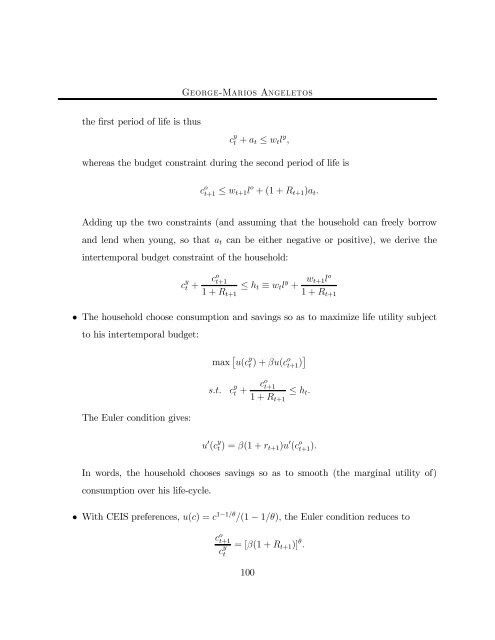14.451 Lecture Notes Economic Growth
14.451 Lecture Notes Economic Growth
14.451 Lecture Notes Economic Growth
Create successful ePaper yourself
Turn your PDF publications into a flip-book with our unique Google optimized e-Paper software.
the first period of life is thus<br />
George-Marios Angeletos<br />
c y<br />
t + at ≤ wtl y ,<br />
whereas the budget constraint during the second period of life is<br />
c o t+1 ≤ wt+1l o +(1+Rt+1)at.<br />
Adding up the two constraints (and assuming that the household can freely borrow<br />
and lend when young, so that at can be either negative or positive), we derive the<br />
intertemporal budget constraint of the household:<br />
c y<br />
t + co t+1<br />
1+Rt+1<br />
≤ ht ≡ wtl y o<br />
wt+1l<br />
+<br />
1+Rt+1<br />
• The household choose consumption and savings so as to maximize life utility subject<br />
to his intertemporal budget:<br />
The Euler condition gives:<br />
max £ u(c y<br />
t )+βu(c o t+1 )¤<br />
s.t. c y<br />
t + co t+1<br />
1+Rt+1<br />
≤ ht.<br />
u 0 (c y<br />
t )=β(1 + rt+1)u 0 (c o t+1).<br />
In words, the household chooses savings so as to smooth (the marginal utility of)<br />
consumption over his life-cycle.<br />
• With CEIS preferences, u(c) =c 1−1/θ /(1 − 1/θ), the Euler condition reduces to<br />
c o t+1<br />
c y<br />
t<br />
=[β(1 + Rt+1)] θ .<br />
100

















